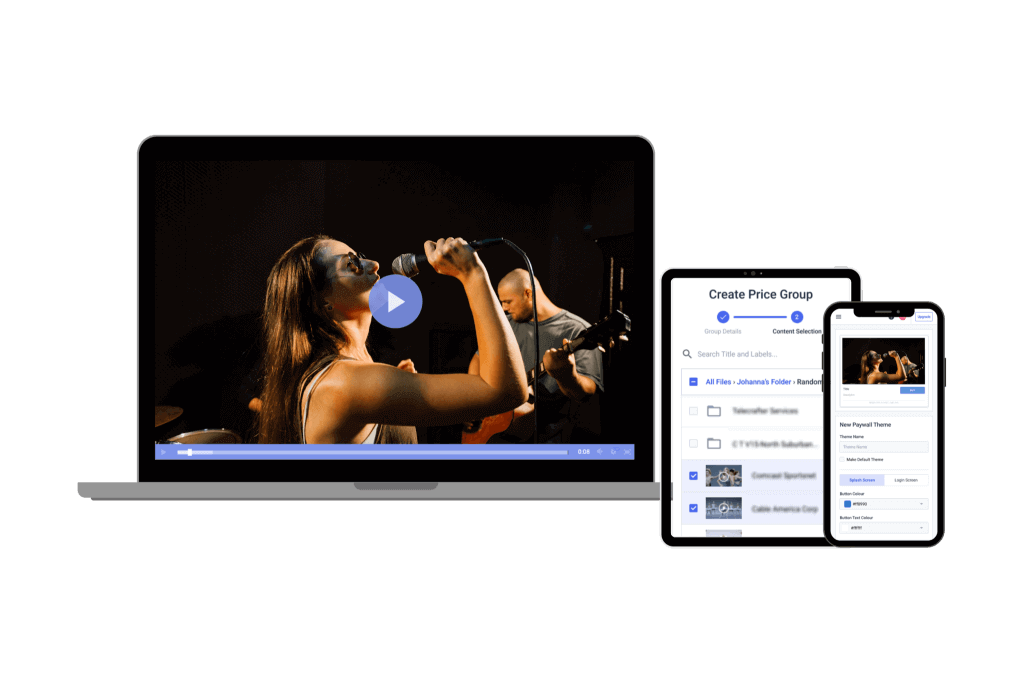Top 115 Live Streaming Statistics Every Broadcaster Should Know [2022 Update]
The live streaming industry is growing faster than ever. However, some people are still unsure whether or not incorporating professional broadcasting into their business is worth it.
We’ve put together the top 115 live streaming statistics that show the growth and current state of the video streaming industry. With these numbers in mind, you should have a clearer image of what live streaming could look like for you.
There is a lot of new information to present and there is a lot to cover. Let’s get started!
Table of Contents:
- The Growth of Live Streaming in 2022
- How Do People Watch Live Streams?
- The Importance of Streaming Video Quality
- Technologies’ Influence on Live Streaming
- Video Streaming Statistics for Business
- Live Streaming Trends in Marketing
- Streaming Stats for Live Events
- Live Video Monetization Stats
- Streaming Industry Security Trends
- Live Video in Education
- Live Streaming Industry Trends and Statistics for 2022
- COVID-19’s Effect on Live Streaming
- Conclusion
This post has been updated to reflect the 115 most accurate live streaming statistics and unique research available as of January 2022.
The Growth of Live Streaming in 2022


1. Live streaming is growing fast. One report, for example, shows that “Live video grew by 93%, with an average viewing time of 26.4 minutes per session.” (Streaming Media, 2019)
2. Live videos hold users’ attention 10-20x longer than pre-recorded, on-demand content. (Forrester, 2017)
3. Of all people who report that they watch live streams, 7 out of 10 of them tune in to a live stream daily. (Interactive Advertising Bureau, 2018)
4. The live music event with the highest live viewership was 2019 Coachella at about 82.9 million live views. (Variety, 2020)
5. The video streaming market will grow to $223.98 billion by 2028
6. The online live streaming industry has grown 99% between April 2019 and April 2020. (Tech Jury, 2020)
7. The live streaming industry is expected to be valued at 184.27 billion USD by 2027. (Tech Jury, 2020)
8. Millennials are the largest group of consumers of live content. 63% of people ages 18-34 are watching live-streaming content regularly. (Neil Patel, 2018)
9. Approximately 34% of Generation Z (which were born between 1997 and 2015) have shown a new interest in live streams, especially on social platforms. (GWI Flagship Report 2020)
10. Younger generations (Gen Z and Millenials) spend more time streaming, whereas older people (Boomers and Gen Xers) watch more broadcast TV. (GlobalWebIndex)
11. Professionals anticipate that 82% of internet use will be for streaming video by 2022. (Cisco, 2021)
12. Professionals also anticipate that 79% of mobile users will be for streaming video by 2022. (Cisco, 2021)
13. Access to exclusive coverage is the reason why 26% of viewers tune into live streams. (GWI Consumer Trends Report 2019)
How Do People Watch Live Streams?
14. By 2022, almost 25% of United States Households will cancel their cable subscriptions. (Adweek, 2019)
15. In 2020, 232 million people watched streaming or downloaded video across all devices in the U.S. (Statista, 2019)
16. 90% of people watch videos over the internet. (PWC)
17. On mobile, people watch videos for an average of 16 minutes a day. (Statista, 2019)
18. On a desktop, people watch videos for an average of 7 minutes a day. (Statista, 2019)
The Importance of Live Streaming Quality


20. The biggest quality issue for live video is now starting failure. Live streams fail to start 2.6% of the time. (Streaming Media, 2019)
21. Quality matters. OTT platforms with lower quality videos run the risk of losing about 25% of their revenue.
22. Online videos with a start-up time exceeding even two seconds have significantly higher streaming video abandonment rates, with each incremental second propelling another 6% of 23. viewers to jump ship. (Akamai)
23. About 66% of video streaming service providers have difficulty determining how much bandwidth they need for high-quality streaming. (Digital TV Europe, 2019)
Technologies’ Influence on Live Streaming


25. The coming 5G cell networks will provide speeds roughly 100x faster than the best available 4G LTE networks. (Streaming Media, 2019)
26. 5G will cut latency by 10x. (Cisco, 2020)
27. 29% of consumers would pay a premium if 5G provided a better quality video on mobile devices and decreased buffering. (PWC, 2018)
28. Access to 5G is predicted to increase revenue from streaming on mobile devices by 85% from 2021 to 2028. (Intel, 2018)
Video Streaming Statistics for Business
29. 77% of employees have experienced problems like buffering while streaming live video at work. (Streaming Media, 2018)
30. As of 2019, 55% of enterprises are now using live video for their company or division-wide broadcasts. (Haivision, 2019)
31. 53% of enterprises stream or broadcast live video in their organization at least once a week, with 29% using it daily. (Haivision, 2019)
32. 65% of enterprises surveyed said they live-streamed to multiple locations. (Haivision, 2019)
33. The top 3 challenges faced by enterprise live streamers include: live streaming to employees working remotely (41%), live streaming from remote locations or conference centers (39%), and managing bandwidth in their facilities (36%). (Haivision, 2019)
34. 81% of Enterprise live streamers display their live video streams or broadcasts on employee desktops. 64% display on mobile devices or smartphones, while 31% used a combination of TVs and screens with set-top boxes. (Haivision, 2019)
35. About 80% of marketing professionals say that video content is becoming more important in the business world. (4CInsights, 2019)
36. Live video campaigns boost video engagement by twice as much for influencer marketing. (RhythmOne, 2018)
37. Nearly a quarter of marketers have reported that live streaming is the most effective tool for promoting trade shows. (The Social Effect, 2019)
38. Two-thirds of marketers that target consumers use live streaming for marketing. (Content Marketing Institute, 2020)
39. Brands are forecast to invest more than $100 billion on video content by 2023. (Forrester, 2018)
40. Video marketers use video content to reduce the necessity of support calls. There are reports that support calls have been reduced by 43% thanks to videos. (Wyzowl, 2021)
41. In 2020, Facebook Live became an important part of marketing strategies where video content was already being used. This increase was about 32%. (Wyzowl, 2021)
Live Streaming Trends in Marketing


43. 35% percent of marketers use live video. This is a rise of 20% year on year. (Mediakix, 2019)
44. In 2018, 60% of viewers conduct online searches while watching a live stream. (Neil Patel, 2018)
45. Animoto’s Social Video Forecast suggests that 76.5% of marketers and small business owners are seeing results with video marketing. (Animoto, 2016)
46. 79% of marketers say live video facilitates a more authentic interaction with an audience.
47. 61% of marketers say a benefit of live streaming video is that it creates content that can be viewed or repurposed later.
48. 60% of marketers say a benefit of live video is getting real-time audience feedback.
49. 82% of viewers say they prefer seeing a live stream rather than a brand’s social posts. (Tech Jury, 2020)
50. 80% of people would rather watch a live video from a brand than read their blog. (Tech Jury, 2020)
Streaming Stats for Live Events


51. Major events are a huge draw for live streaming. The US saw a 217% spike in live news viewership with the midterm election, and the World Cup lifted overall global traffic up by 29%. (Conviva, 2018)
52. 67% of live video viewers are more likely to buy a ticket to a concert or event after watching a live video of that event or a similar one. (Amp.Live, 2017)
53. Breaking news makes up 56% of most-watched live content. Conferences, speakers, concerts, and festivals are the second most popular type of content at 43%. (Livestream, 2018)
54. Sporting events account for 86% of live-streamed content. (99 Firms, 2019)
55. Half of sports broadcasters say that latency poses a challenge when streaming real-time sports events. (Digital TV Europe, 2019)
Live Video Monetization Statistics


57. Companies that use video features grow revenue 49 percent faster than non-video users. ( Wordstream, 2020)
58. Every area of home entertainment spending has declined over the past five years—except online video. (Streaming Media, 2019)
59. Streaming is going global. Seventeen countries are expected to generate $1+ billion in video streaming revenue by 2023. (DigitalTV, 2018)
60. According to a Digital TV Research report, advertising revenue will reach $47 billion by 2023. (DigitalTV, 2018)
61. More than a third of professional broadcasters monetize their content via subscription models. (Bitmovin, 2017)
62. 70% of marketers say that video produces more conversions than any other content. (Hubspot, 2017)
63. 45% of live video audiences would pay for live video from a favorite sports team, speaker, or performer. (Livestream, 2018)
64. By 2021, there are expected to be 383 million SVOD subscriptions worldwide. ( Techjury, 2020)
65. Subscription-based video on demand revenue is predicted to grow by 10.7% each year to yield a market volume of $85,735 million by 2025. (Statista)
66. More than half of viewers would prefer to watch ads on their live streams than pay a subscription. (Interactive Advertising Bureau, 2018)
Live Streaming Industry Security Trends
67. Akamai has found that credential theft for online video subscriptions is a major issue. Millions of accounts are compromised every year. (Streaming Media, 2019)
68. Piracy costs the online video industry up to $71 billion each year. (CNET, 2019)
69. Working with multiple video players and DRM technologies poses a challenge according to 38% of streaming service providers. (Digital TV Europe, 2019)
Live Video in Education


71. eLearning is expected to be worth $325 billion by 2025. (Forbes, 2018)
72. 81% of students report that digital learning technology (including video) helps them learn. (Statistica, 2020)
Live Streaming Industry Trends and Statistics


74. Approximately 79% of U.S. households access paid or ad-funded streaming services as of June 2020, which is up from 76% 6 months earlier. (Think with Google)
75. About 1 in 5 people discover new products and brands through social media live streams. (GWI Social Media Trends Report 2020)
76. 39% of sports fans tune into social media live streams to watch their favorite teams and sporting events.. (GWI Social Video Report 2019)
77. Around 29% of internet users accessed live stream function on their preferred social media platform in May 2020. (GWI Live Streaming 2020 Infographic)
78. Social media live streaming became popular among younger generations, but it is slowly attracting older generations.
79. The ability to engage with other fans is important in sports live streaming. Nearly a quarter of viewers post comments on the live events they are tuned in to. (GWI Social Video Report 2019)
80. Live streaming on LinkedIn Live has grown in popularity by 158% from the first to the third quarter of 2020. (LinkedIn, 2020)
81. Engagement on live videos on LinkedIn is exponentially higher than posts with pre-recorded video. Live videos average 7x more reactions and 24x more comments. (LinkedIn, 2020)
82. A mere 3% of marketers currently use the live streaming function on LinkedIn. (Social Media Examiner, 2020)
83. 28% of Facebook users view a live stream on the platform each month. (GWI Trends Report 2019)
84. In 2018, the MLB made a deal with Facebook to live stream 26 games, which generated over 123 million views. (GWI Trends Report 2019)
85. About 13% of all live stream viewers on social media are on Instagram. (GWI Social Video Report 2019)
86. The use of Instagram’s “Live” feature grew by 70% in April 2020. (Business Insider, 2020)
87. About 17% of digital marketers incorporate Instagram Live in their content strategies. (Social Media Examiner)
88. Less than 10% of marketers incorporate YouTube Live in their marketing strategies. (Social Media Examiner)
89. About a quarter of TikTok users used the platform to tune into a live stream in June of 2020. (Digital Information World)
90. Approximately 46% of TikTok Live users are Gen Zers, 47% are single, and 20% are students. (GlobalWebIndex)
COVID-19’s Effect on Live Streaming


92. At the beginning of lockdowns, 1 in 10 people in the United States and the United Kingdom began to broadcast live videos of their own. (GWI coronavirus Research March 2020)
93. COVID-19 lockdowns say more male users produce live videos than females. (GWI coronavirus Research March 2020)
94. Nearly a quarter of viewers report that they will continue to stream more “post-COVID-19.” (GWI Flagship Report 2020)
95. Live streamers made up a little more than a third of all internet users in March and April 2020. (GWI 2020 Live Streaming Trends)
96. Virtual events were quickly put together to accommodate people who couldn’t attend in person due to the coronavirus. (GWI coronavirus Research March 2020)
97. Viewers prioritize lifelikeness in live streams. They want virtual events to mirror in-person events. Over a third want high-definition video and don’t want ads. (GWI coronavirus Research March 2020)
98. Search engines saw a 300-500%increase in searches for live streaming platforms during the middle of March 2020. (Google Trends)
99. Live stream watch time has increased by 250%. (Think with Google, 2020)
100. Approximately 44% of Brazilians streamed video content on smart TVs and streaming services during the lockdown. (GlobalWebIndex)
101. There is a rising demand for live broadcast theater performances. (GlobalWebIndex)
102. Half of the people in the world watched news coverage from home during the lockdown. (GlobalWebIndex)
103. Streaming during business hours surged by 60% at the beginning of COVID-19 lockdowns in Spain. (Diario Jaén)
104. The first quarter of 2020 saw a 40% increase in SVOD viewing in the United States as compared to the months leading up to that. (Reelgood)
105. When lockdowns started in March 2020, 68% of Disney Plus viewers in the United States started streaming more. Viewership on Netflix and Hulu increased by 66%. (nScreenMedia, 2020)
106. Several European countries saw a boom in time spent streaming over the weekend of March 13, 2020. There was a 40% increase in Austria and Spain and a 32% increase in Germany. (Bloomberg)
107. In the United States, 29% of people showed interest in tuning into live-streamed events and performances during COVID-19 related lockdowns. (GWI coronavirus Research March 2020)
108. Over a quarter of music fans in the United States and the United Kingdom reported that they’d be interested in seeing more music events, particularly DJ sets, broadcasted going forward. (GWI coronavirus Research March 2020)
109. The fitness industry experienced a major boom, with an increase of over 1300% in minutes live-streamed, in the first six months of lockdown (March to August). (Uscreen, 2020)
110. Remote education (via live stream) experienced an increase of over 980% in minutes live-streamed between the spring and fall semesters of 2020. (Uscreen, 2020)
111. Wellness content, specifically related to yoga and meditation, experienced an increase of 392% in minutes live-streamed in the second and third quarter of 2020. (Uscreen, 2020)
112. Once COVID-19 began to spread across the United States, 11,000 houses of worship invested in a live streaming platform. Over 4.7 million worshipers turned into live-streamed services. (The Washington Post, 2020)
113. Church services rose in streaming minutes by 40% in the first six months of lockdown (March to August 2020). (Uscreen, 2020)
114. On Easter Sunday in 2020, church services made up over 30% of the country’s top 100 live streams in the United States, Mexico, and Brazil. (Think with Google, 2020)
115. Due to the ongoing pandemic, live streaming e-commerce is the fastest-growing internet sector in China, with 309 million, or roughly a third of China’s internet users, tuning in (KR-Asia 2021)
Conclusion
These live streaming statistics paint a picture of a vibrant industry that is on the rise. Businesses that are looking for a way to connect with their audiences are wise to start incorporating live streaming and on-demand video content into sales, marketing, training, and more.
If you’re looking for a new professional live streaming solution, you should consider Dacast. Dacast provides professional video hosting for both live and on-demand content to business clients around the world. We offer all the advanced streaming features that broadcasters need to create a successful stream.
If you’re ready to try live streaming with our solution today, take advantage of our 14-day free trial. All you have to do is sign up today. No credit card is required.

 Connect
Connect
 Events
Events Business
Business Organizations
Organizations Entertainment and Media
Entertainment and Media API
API Tools
Tools Learning Center
Learning Center Support
Support Support Articles
Support Articles